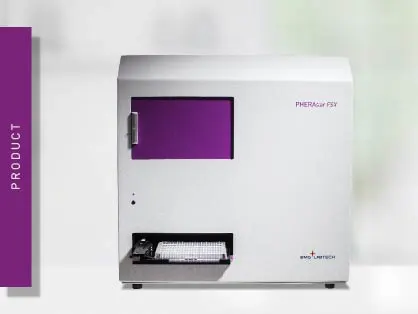
PHERAstar FSX
Powerful and most sensitive HTS plate reader

Martin Redhead (Head of Quantitative Pharmacology at Exscientia)
Applying artificial intelligence (AI) to small molecule drug discovery can provide a more rapid and cost‑effective route to discovering drug candidates. Here, Martin Redhead, Head of Quantitative Pharmacology at Exscientia, discusses the role of AI in drug discovery, the processes involved and how it can be used to address the current pandemic.
In what ways is the drug discovery environment changing? What role does AI play and how do real-time kinetic binding assays support this approach?
Despite increased investment, the productivity of pharma R&D has been decreasing. Central to this is the inefficiency of drug discovery, where huge amounts of data across multiple parameters either exist and/or are generated over the course of a drug discovery campaign. It is impossible for a scientist to consume and analyse this data and then make the most efficient decisions alone. In the small molecule field, we were the first to demonstrate that AI algorithms can outperform human drug designers in the search for optimised drugs. Real-time kinetic binding assays are just one example, where huge amounts of data are generated but traditional analysis techniques fail for all but the simplest models. Here, AI can more effectively search the solution space to tell us what our drug is really doing, allowing us to make more informed decisions.
You combine the analytical power of AI with the expertise of scientists. What are the benefits of this approach?
We have shown that the combination of AI with strategic direction from humans allows us to discover drugs more quickly and efficiently than conventional approaches. We call this approach the Centaur ChemistTM. Drug discovery scientists are liberated to spend more time guiding workflows and the strategic direction of projects whilst AI deals with tactical challenges and manipulation of complex multi-dimensional data. In addition, AI is free from bias and as a result often provides novelty in designs that can open new lines of research. The analytical power of AI combined with the strategic guidance of our experienced drug discovery teams enables progression from a hit compound to a clinical candidate in fewer than 400 compounds; that is 10-fold less than traditional approaches.
Prior to the current pandemic, virology was not on the top priority list of many pharma companies. Now that fast progress in the field is imperative, how can your applied use of AI accelerate results?
We recognise that the COVID-19 global pandemic needs solutions in the short term, but we also need to think longer term to the possibility of another coronavirus epidemic. To address the short-term problem, we have collaborated with Scripps Research Institute in the US and Diamond Light Source in the UK to screen 12,000 molecules that are ready for human trials to try and repurpose a molecule quickly. For the longer term, we are part of a European IMI initiative to develop new coronavirus drugs for the future. Here, our AI will design safe, targeted novel compounds that are future-proofed to lessen the impact of any future pandemic.
What role do microplate readers play in your work and which requirements are needed to keep up with your necessities?
Our algorithms learn from data they are presented with, so assay quality is critical. To generate the data that the AI algorithms require in order to learn how to design a candidate, we rely on plate-based assays for most of the biological data. We need instruments that are flexible to handle multiple different assay technologies such as fluorescence, HTRF, luminescence and BRET as we work across multiple target classes requiring various technologies for assays. In the case of targets with little or no chemical matter, we generate ‘seed data’ for the AI, so we also need sufficient throughput to screen larger sets of compounds.
You have chosen the PHERAstar FSX plate reader as a core screening instrument in your laboratory. What criteria did you use in your evaluation?
We needed a flexible, sensitive instrument with the ability to screen in ‘high-throughput’ mode. We also needed the option of running kinetic assays for projects that required more in-depth pharmacological analysis. The PHERAstar FSX can deliver on all of these fronts and means we only need a single plate reader rather than a collection that are suited for single tasks.
The interview was firstly published on drugtargetreview.com
Powerful and most sensitive HTS plate reader